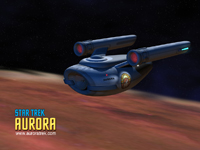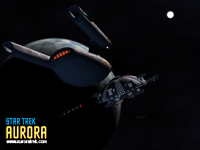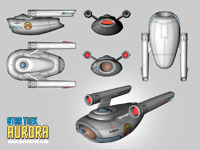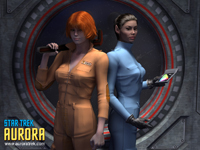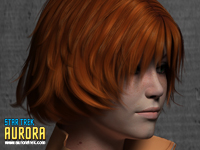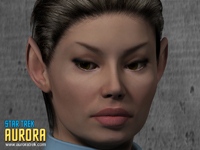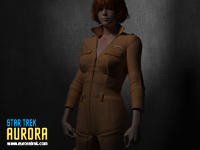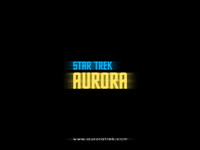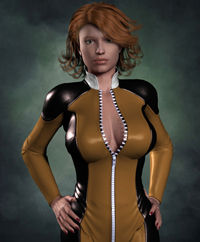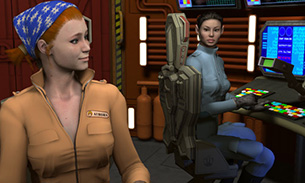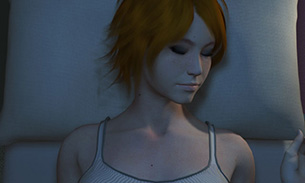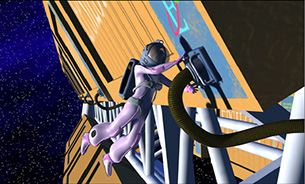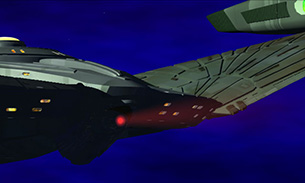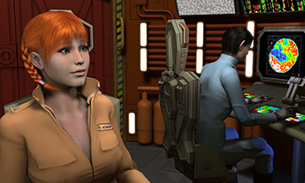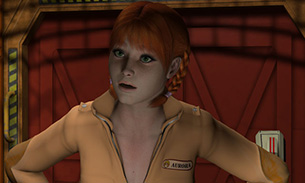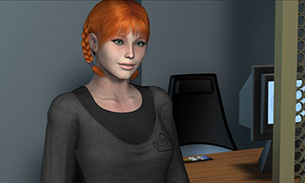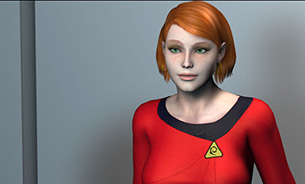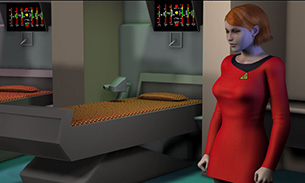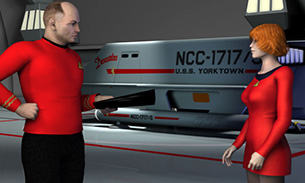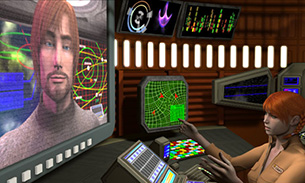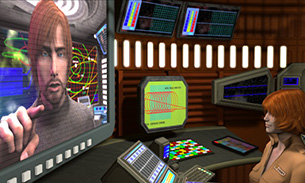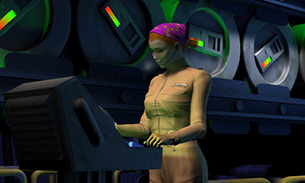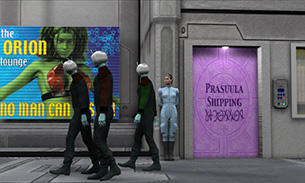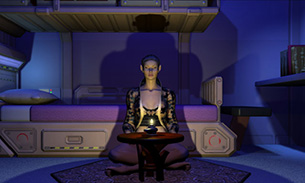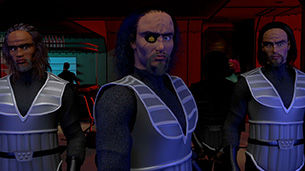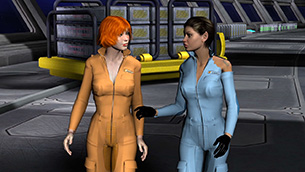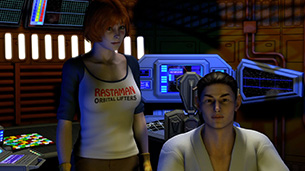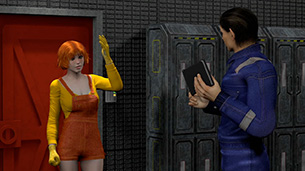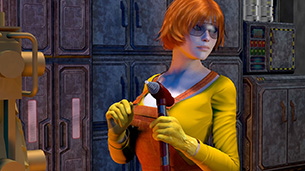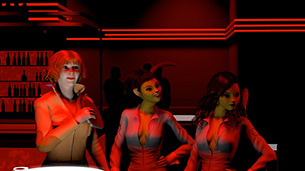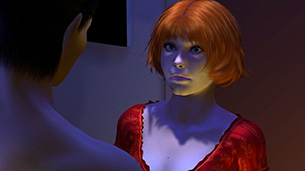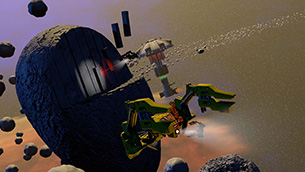






Desktop wallpapers (1024x768):
Click on thumbnail to download
Music downloads (mp3):
–Coming soon–
Fan art:
Banners thanks to Michael R.:
Wallpapers thanks to Bognár András:
Wallpapers and banner thanks to James Jones:
Image thanks to George Haze:
Image thanks to Beniamin Glaza:
Screen Shots:
Ship Specifications:
Technical specifications for some of the unique ships in Aurora, courtesy Samuel Noyes, who might have been reading my mind in creating these specs with just some bare-bones input from me, and whom I freely thank and credit for coming up with the name "Monitor Class" for Aurora's original ship class:
S.S. Aurora
Class Name: Monitor Class (Refitted)
Class Type: 2159 Gunship- 2270 Merchant Vessel/Light Freighter
Year Introduced: 2159 Monitor Class Gunship-2270 Refit into Merchant Vessel
Availability: Kara Carpenter/TLing Only
Estimated Constructed: One Only
Specifications
Armament: 1x Multi Purpose Deployment system
Shields: 60,000 TJ High Capacity Shield System
Hull: Heavy Monotanium Double Hull
Armour: Radiation Proof/ Equivalent 60cm Anti-Phaser Hull Coating
SIF: High
Normal Cruise: Warp 5
Maximum Cruise: Warp 5.5
Maximum Rated: Warp 6 for 12 Hours (Warp 5 At Maximum Cargo Capacity)
Crew: 1-2
Length: 36 meters
Decks: 2
Shuttles: None
Escape Pods: 2
Transporters: None
Ship Interior: The Bridge, 2 Births, A Galley, A Head, Engineering, Cargo Bay
Sensors: Standard Civilian Sensor Array
Combat Manoeuvrability: 6000
Expected Hull Life: 200 Years
Weapons Range: 0
Overall Strength: 285
Historical Notes
After the bloodshed of the Romulan Earth War three Monitor Class Gunships were mothballed at Deneva Colony due to the extreme difficulty in refitting them for duties within the United Federation Of Planets. Regarded as unfit for Federation duties the three ships were stripped of major components and had their weapons systems removed, then mothballed in a Shipyard. For some 100 years the three Monitor Class hulls languished until a former Federation citizen by the name of Kara Carpenter came across the hulls. The young Kara Carpenter having spent the majority of her life in and around space saw great potential in such a heavily armoured hull. Having lived at Deneva Station with her Aunt for many years during her schooling, she began trading her labour and repair skills for the useless hull of U.S.S. Monitor XGS-01 as well as spare parts. Over several years she worked on her ship in her spare time, adding new components, replacing old and outdated systems, re-building the ship from scratch. Kara had made many changes and upgrades to her ship including:
1. Installing a navigational deflector dish in place of the main turret housing
2. Replacing the warp core with a modern warp 6+ capable warp core
3. Interior changes to the warp coils to coincide with the warp core upgrade
4. Adding retractable armour to the Bussard collector and deflector dish housings
5. Replacing the impulse engines with a larger, more advanced version due to the additional space created by removing the aft laser turret housings
6. Installing high powered deflector shields
7. Upgrading the Multi Purpose Deployment system for Cargo Handling
8. Installing a new Sensor Array
9. Installing a modern communications system
10. Adding a food Replicator
11. Replacing almost every ancillary system onboard
12. Interior cosmetic changes
13. Using ladders instead of lifts and simple hydraulic systems that were less prone to breakdown
After several years of hard work, Kara had almost finished her ship which she had named Aurora after the ship her unconfirmed ancestor (Scott Carpenter) flew named Aurora 7. Kara had the Goddess of the Dawn, Aurora painted on the hull with a crescent moon as her brow. After Aurora had been refitted enough for use, Kara had Aurora transported aboard a large bulk freighter to Xaneerian Space due to the distance being too far for Aurora to travel alone, coincidentally the same way the Monitor Class was deployed. Kara worked as a Satellite Repair Technician for her first year repairing satellites around the Xaneerian system and just inside the Thundercloud Nebula. Though this was interesting work Kara felt it was too lonely even though she herself was a loner. It was there she inadvertently discovered the many safe holes where a starship could traverse. Realising that with the Aurora being so heavily armoured against radiation, with a proper navigator she could traverse the dangerous Thundercloud Nebula. After a few weeks of advertising she managed to hire a Vulcan by the name of TLing who had just arrived in the region. There the Aurora Gals as they became known, quickly became well known cargo haulers and had attracted competition in the from of the crew from the S.S. Lone Star as well as several other ships by consistently outrunning them to their destinations throughout Xaneerian Space.
Authors Notes
A few issues that might catch peoples attention. While the Aurora does possess a Warp 6+ engine which on normal vessels this size can push warp 6.2/ warp 6.3, Aurora can only achieve a maximum of Warp 6 unloaded and Warp 5 when loaded due to the weight constraints created by the armoured hull. Significant modifications were made to the warp nacelles to enhance the warp field to counteract this weight problem. Captain Carpenter did not install transporters aboard Aurora due to the armoured hull being impossible to beam through without considerable hull re-working, also that a transporter would be out of the question with Karas low tech approach to her ship. The retractable armour plating used on the warp nacelles and the deflector dish was built to the same specs as the armoured hull of the ship as anything less would result in a radiation risk. An interesting point about this beautiful ship is that pirates/raiders wouldnt dare try and plunder her cargo as the armoured hull prevents beaming due to it being hard shielded and weapons fire would have little effect, in other words A Pirates Nightmare.
Specifications Layout courtesy of DITL and Copyright Graham Kennedy
Star Trek Aurora Copyright belongs to Tim Vining
Monitor Class Gunship (Aurora's original specs)
Class Name: Monitor Class
Class Type: Experimental Gunship
Year Introduced: 2159
Availability: Military Only
Estimated Constructed: 3 Only
U.S.S. Monitor XGS-01
U.S.S. Ericsson XGS-02
U.S.S. Dahlgren XGS-03
Specifications
Armament: 1x Ball Turreted Dual Laser Cannon 600 TW
2x Single Laser Cannon Turrets 600 TW
1x Multi Purpose Deployment system
Shields: 10,000 TJ High Capacity Shield System
Hull: Heavy Monotanium Double Hull
Armour: Radiation Proof/ Equivalent 60cm Anti-Phaser Hull Coating
SIF: High
Normal Cruise: Warp 1
Maximum Cruise: Warp 1.5
Maximum Rated: Warp 2 for 12 Hours
Crew: 2-4
Length: 36 Meters
Decks: 2
Shuttles: None
Escape Pods: 2
Transporters: None
Ship Interior: A Bridge, Crew Births, Engineering, Cargo Bay
Sensors: Standard Military Sensor Array
Combat Manoeuvrability: 2000
Expected Hull Life: 200 Years
Weapons Range: 40
Overall Strength: 269.516
Historical Overview
In Early 2159 the Earth-Romulan Conflict had been raging for nearly 3 years with the Romulans now on the defensive from the fearsome attack launched by Earths Daedalus Class Starships. Even so they were still managing to inflict damage upon Earths Colonies which were located just inside Earth Space. Within Earth space there is a nebula known as The Denevan Nebula located near Deneva Colony, this nebula is extremely hazardous due to the intense radiation present and that sensors and shields are non-functional within the anomaly making safe travel through it impossible. The Romulans were using this to their advantage by launching sneak attacks from around the nebula which prevented Earth ships and Deneva colony from detecting their approach. Earths Admiralty decided that this was an unacceptable situation and that action must be taken, unfortunately none of their existing strategies or Starships were able to provide any effective relief from these attacks for the colonies in the area.
About a month after the Admiralty had decided that action would need to be taken, blueprints for a high powered short range Gunship were submitted to the Starship Design Bureau. This class of ship would have a large amount of armour combined with heavy weapons for a ship of its size. The tactical systems included a ball turreted dual laser cannon at the bow and two individually turreted laser cannons astern designed for close quarter combat as no missile weapons were included. These weapons while not as powerful as the Daedalus Classs lasers, were still very dangerous especially mounted on a ship of this size. This new ship would also feature a brand new system named The Multi-Purpose Deployment System which could be used to store/deploy many different types of equipment ranging from Sensor Relays, Cargo. Troops, Mines etc. This system would allow the Gunship to perform multiple other functions outside of its primary function of combat and used an external deployment bay on the ventral hull to achieve this. The armour the Gunship possessed was sufficient to repel most attacks from Romulan weapons at a distance. The shields were also very strong for a ship this size and allowed this class of ship to remain in combat much longer than any other previously fielded Gunship. Due to the vessels small size, the ship would have a top speed of Warp 3.
After reviewing the design and coming to a decision, the Admiralty initially rejected the design as being too slow and of little use in the now offensive campaign against the Romulans. Undeterred the Ships Chief Designer Timothy Vining began designing a more offensive vessel, until a report caught his attention about a recent major attack on Deneva Colony close to the Denevan Nebula. This report emphasised the ease at which the Romulans had evaded long range sensors long enough to get into striking distance of the colony and caused massive damage as a result. Realising the seriousness of these attacks, inspiration struck Timothy, since the Gunship was supposed to be able to survive Romulan nuclear weapons, the ship might be modified to fly through the nebula and other harsh environments without risk of destruction. Immediate work was begun on the latest experimental armour research and hull construction methods. Just two weeks later the Admiralty were reviewing a new version of the Gunship. While the warp core, armaments and other main systems were identical, the Hull and the Hull Armour were greatly increased to the point where they could withstand huge amounts of radiation and weapons fire, though at a cost to the ships maximum warp speed. Emphasis was placed on deploying this class of ship within the Denevan Nebula and to use sensor relays to coordinate precision attacks on the Romulans while they tried to traverse around it. The Admiralty immediately ordered that the class be commissioned with haste. Due to the similarities in design, purpose and construction history the class name Monitor was chosen from an ancient revolutionary warship from the American Civil War of 1862.
Construction began on 3 Monitor Class Gunship hulls which were laid down within a few weeks. Shortly afterwards USS Monitor XGS-01 left the slipway under her own power. The sheer mass of the Gunship was enormous considering the performance of the impulse engine that was propelling the vessel, while this left the Monitor slow and sluggish at both warp and impulse, the operational range of this vessel was never going to be very large. A large Cargo Freighter was modified to carry USS Monitor to The Denevan Nebula where the crew and support personnel were waiting to begin operations. Within days USS Monitor had its first taste of combat, a small Romulan attack group was again traversing around the nebula to attack a nearby freighter convoy carrying relief and medical supplies for Deneva Colony. U.S.S. Monitor was already waiting for them as the Sensor relays she had been carrying had been deployed around the region, when the Romulans were in range U.S.S. Monitor exited the nebula and fired upon several unsuspecting ships instantly destroying them. The remaining craft returned fire with atomic weapons but no avail, they made a hasty retreat after realising how outmatched they were. Throughout the remainder of the war the Romulans would repeatedly try and destroy U.S.S Monitor and the sensors that she had deployed. Matters were made worse for them when the U.S.S. Ericsson and U.S.S. Dahlgren joined their sister ship. This was the final nail in the coffin for the Romulan Empires Expansion plans was after their only avenue for attack was cut off, they were soon in a war they could never win. No more Monitor Class Starships were constructed after U.S.S. Dahlgren as the design was very costly to construct due to the absurd amounts of armour and that the Denevan Nebula and the nearby colony were very well defended by the 3 currents Monitor class vessels already deployed there.
In 2160 the Romulans sued for peace and the war ended after the massive Battle Of Cheron where the Romulans were annihilated by Earth Forces. In 2161 The United Federation of Planets was formed and began exploring the space around them. Unfortunately the Monitor Class was not to be a part of this endeavour as they were pure combat vessels which had little place in Starfleet, even though they were augmented with a few non-combat systems, they were too slow to make it back to Earth plus the ship that transported them to the area originally had been destroyed by the Romulans. Starfleet considered modifying them into cargo vessels but the hull and the hull armour made them unsuitable. The hull would also prevent the ships from being cut up for scrap either as they were extremely difficult to destroy. Eventually they were mothballed at Deneva where they were stripped of all their tactical systems and left in an orbiting shipyard where they were quietly forgotten.
Authors Notes
Basically this class of ship was designed to be thrown into the most dangerous areas known to man, whether they be combat or environmental in nature. As Tim and I have discussed, the ship is essentially A Flying Brick which was designed to be built like a tank and even though it has a strong overall strength rating compared to other ships at DITL and appears way to strong, remove the armour and youll find the ship fits very nicely with an overall strength of 23.698. This is about half of what the Daedalus Class is given. Weapons should be about right as well as shields and speed which is lower than the most of the ships in the Romulan-Earth War. Now the hull life is a conservative estimate knowing how tough it is considering atomic weapons, dangerous nebulas were unable to damage it significantly as well as how expensive it would have been to cut the hull up for scrap.
Note that Tim is following the old Original Series version of events for the Romulan-Earth War with the use of primitive atomic weapons rather than the events of Star Trek Enterprise.
Specifications Layout courtesy of DITL and Copyright Graham Kennedy
Star Trek Aurora Copyright belongs to Tim Vining
S.S. Mercury Rising
Class Name: Jupiter Class
Class Type: Merchant Vessel/Freighter
Year Introduced: 2200s
Availability: Civilian and Military
Estimated Constructed: Several Hundred At Least
Specifications
Armament: None
Shields: 20,000 TJ Low Capacity Shield System
Hull: Light Monotanium Single Hull
SIF: High
Normal Cruise: Warp 3
Maximum Cruise: Warp 3.5
Maximum Rated: Warp 4 for 2 Hours (Warp 3 for 2 Hours When At Full Cargo Capacity)
Crew: 2-10
Length: Approx 60-100 Meters Depends On Number Of Cargo Modules
Decks: 4
Shuttles: None
Escape Pods: 6
Transporters: 1x Single Pad Transporter
Sensors: Standard Civilian
Combat Manoeuvrability: 1000
Expected Hull Life: 100 Years
Weapons Range: 0
Overall Strength: 15.211
Historical Notes
Commissioned around the early 2200s, the Jupiter Class Freighter was a basic haulage design which was operated by mainly civilians and families. While the Jupiter class was considered adequate for civilian use when it was first introduced, by the mid 23rd Century it has fallen behind the standard for freighters and lacks many current systems. People who still used them upgraded the first chance they had like to install replicators, better shields, more sophisticated sensors and faster warp drive. Weapons were never designed to be installed aboard Jupiter Class Freighters as they were originally supposed to be used in convoys and safe space lanes. This left them with the tendency to be quite vulnerable and often needed escort through more dangerous regions of space.
The S.S. Mercury Rising is a Jupiter class Freighter operated by the Carpenter family throughout the Federation running freight from Deneva to other worlds. Mercury Rising was built in 2202 and has been crewed by Carpenters since the day it left the shipyard and has spent 2 generations with the family. The Carpenter family is claimed to have had history with space since the days of the Mercury Space program that was in operation in the 1960s when Scott Carpenter launched into space in the Aurora 7. Records after WWIII are unclear about the family line but the Carpenters defend the claim staunchly. The Nose art for the Mercury Rising is the God Mercury from a 20th century US Mercury head dime coin with the background from Scott Carpenters Aurora 7s mission patch. Modifications to the ship included emergency transporters and minor upgrades to main systems to keep the ship operational.
Early in 2262 the Carpenter Family were transporting cargo from Deneva to Bolarus when the ship was caught in an Ion Storm. Ion Storms are very dangerous for freighters as most are either not strong enough or the crews are not experienced enough to traverse one. Fortunately the Carpenter Family managed to survive the storm but were unable to gain a navigational fix on their position. It was surmised that the storm had blown them off course and that due to damage they were unable to locate themselves. After starting repairs to their vessel, an unknown ship which was testing a previously unknown stealth device in the area began stalking the Mercury Rising. The Carpenters made repeated attempts to identify the other vessel and to initiate communications but received no reply. With Kara Carpenter (The youngest of the Carpenters onboard) still performing an EVA on the outer hull reconnecting power lines, the ship was unable to move as the unknown ship circled around the harmless freighter. As Kara barely managed to get back into the airlock the Unknown ship re-appeared ahead of the vessel, Karas father ordered a sensor scan of the vessel which seconds after initiating was responded to with a photon torpedo. Against the power of a torpedo, the ships shields absorbed some of the blast but they failed stop all of it and the entire bridge section was ripped open to the vacuum of space killing everyone but Kara who was still in the airlock in an EV suit. Had the ships shields not been raised it is likely the whole vessel would have been destroyed instantly. The ships computer shows that nearly all of the systems were damaged beyond repair and that the vessel drifted for months until being found. Several years later after Starfleet intercepted a Romulan ship the Mercury Risings destruction was re-investigated as the description of the attacker was similar to the Romulan craft. Eventually it was determined that the attacking vessel was a Romulan Bird Of Prey and that the Romulans were indeed responsible. As the ships records were unclear as to the position of the Mercury Rising, the Federation did not respond by declaring war with the Romulans as there was insufficient evidence as to the Mercury Risings location, the only known records are located with the Romulan ship that destroyed Mercury Rising. Two possibilities were accounted for that either the ship had drifted into Romulan Space accidentally or that the Romulans had secretly managed to cross Federation Borders via some unknown method and destroyed Mercury Rising. A general Open verdict was given as to why the ship was destroyed and no culpability was placed on Captain Carpenter.
Authors Notes
Just your basic freighter with a family crewing her. The shields are sufficient for a single 23rd Century photon torpedo to damage the ship and destroy the bridge without destroying the entire ship. Warp speed is about right as single nacelle designs suffer from poor speed and sustainability. Very little to say other than that.
Layout courtesy of DITL and Copyright Graham Kennedy
Star Trek Aurora Copyright belongs to Tim Vining
S.S. Lone Star
Class Name: Santa Maria (Heavily Customised)
Class Type: Medium Freighter
Year Introduced: Unknown
Availability: Randy Jacobs
Estimated Constructed: Only One Known
Specifications
Armament: 2 x 1000 TW Single Type V Phaser Banks
Shields: 120,000 TJ Military Grade Shield System
Hull: Standard Monotanium Single Hull
Armour: Equivalent to 1cm Anti-Phaser Hull Coating
SIF: Standard
Normal Cruise: Warp 6
Maximum Cruise: Warp 6.5
Maximum Rated: Warp 7 for 2 Hours (Warp 6 At Maximum Cargo Capacity)
Crew: 5
Length: Approx 80 Meters
Decks: 2
Shuttles: N/A
Escape Pods: 2
Transporters: 1 x Three Man Pad
Ship Interior: Bridge, Engineering, Cargo Bay, 6 Crew Berths, Crew Mess, Head, Galley, Recreation Room/Sick Bay, 2 Large Detachable Cargo Pods
Sensors: Standard Civilian Sensor Array
Combat Manoeuvrability: 3000
Expected Hull Life: 50 Years
Weapons Range: 80
Overall Strength: 64.872
Historical Notes
The Lone Star, owned and captained by Randy Jacobs of the Famous Jacob Family renowned in the shipping world, is a modified Santa Maria Class Scout that was used in the very beginning of the 23rd Century to scout out new worlds beyond Federation space. These Scouts were built to be customised due to their very modular nature meaning that no two ships were built the same apart from the basic space frames and some systems. Usually ran by civilians these scouts would explore new trade routes for interstellar commerce. While not having the vast resources of Starfleet as well as powerful ships, these scouts were operated by family businesss as they were cheap to operate and very durable. The Jacobs family owned several of these ships and while most of the other scouts were sold off or scrapped, the Jacobs held on to a few of them.
In the 2260s the Jacobs family were still a major family business and were well regarded by the people who the operated with. Unfortunately every family has its own black sheep, Randy Jacobs is no exception. Although the exact details about Randys troublemaking are unclear, what is known is that one of the old scouting vessels was modified to be used as a freighter by the family and that Randy was sent off to Xaneerian Space to in the words of his father Open a new trading opportunity. Rumour has it though that the other Jacobs family members wanted Randy as far away from their business as possible.
The Lone Star was originally modified with 2 large cargo pods and an upgrade to most of its systems to keep the ship more or less up to date. The ship has since been modified over time by Randy to include Type V Phaser Banks, a Military Grade deflector shield, a Warp 7 engine, Transporters and numerous other systems. These modifications specifically to the tactical systems would be considered downright illegal within the Federation and would allow the Lone Star to engage a small Starfleet vessel and emerge victorious. Though by no means is she intended for combat, she could hold her own if attacked. No doubt that if Randy Jacobs ever took the Lone Star into Federation space, his ship would be impounded the moment anyone from Starfleet scanned his vessel. The Lone Star usually carries a crew of around 5 including Randys friend Chug. The Lone Star has 6 crew berths and a recreation room for long voyages making her one of the more comfortable freighters in Xaneerian space.
The Lone Star has been operating in Xaneerian Space since the mid 2260s when Randy was Sent there. Up until 2269 the Lone Star was the fastest cargo ship running freight in Xaneerian Space when the .S.S Aurora under Captain Kara Carpenter arrived and somehow outran every other freighter in the region, though curiously with a lower top speed than Lone Star. Randy is obviously bemused by how the Aurora, a one hundred year old ship with a slower warp drive can outdo his heavily customized Hot Rod of a ship. Randy has had to compete with Kara consistently as many of the same companies that employ Randy also employ Kara as well.
Authors Notes
The Santa Maria Class Scout is your very basic ship designed to be added to over time, anything that the owner wants to be installed can be installed. There are no baseline specs for the Santa Maria class as each ship was built to include different Warp Drives, Shields, Weapons for whatever mission profile they were requested for. Most were customised for Scouting and Freight though.
Overall the Lone Star is faster and stronger than the .S.S Aurora as well as nearly every other freighter. It carries moderate weapons as well as a powerful shield system which can take considerable punishment, a lot more than any normal freighter could take. The Lone Star is more than capable of dealing with pirates on its own without assistance either by outrunning them or outgunning them. It possesses a powerful Warp 7 engine and is one of the best civilian freighters around in the 2260s - 2270s time period.
Specifications Layout courtesy of DITL and Copyright Graham Kennedy
Star Trek Aurora Copyright belongs to Tim Vining
![]()
Star Trek and related marks © CBS Television and Paramount. Characters, images and story, except where specified, ©2008 by Tim Vining
